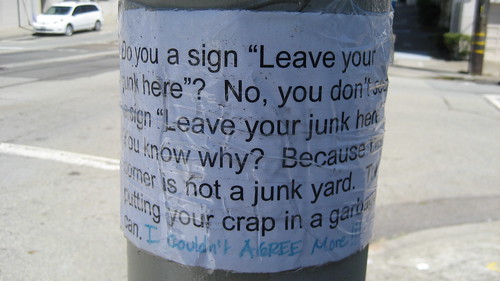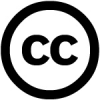NPR happened to have a couple of reporters in Sichuan when the earthquake hit. The other day I heard this story on NPR. It is a story of one family bringing in an excavator to try and recover people from the rubble. It is very touching and emotionally difficult to listen to. The reporter’s voice is choked up and failing at the end of the twelve minute piece, which concludes with a great deal of heartfelt wailing and people setting off firecrackers for the dead. The government is estimating 50,000 dead. Horrible horrible news. you can read the contents of the NPR story on the reporters’ blog.
Feedback Welcome
From the L.A. Times:
SAN FRANCISCO — — The California Supreme Court ruled today that same-sex couples should be permitted to marry, rejecting state marriage laws as discriminatory.
Awesome!
Feedback Welcome
As seen on Judah:

Do you see a sign “Leave your
junk here”? No you don’t see
a sign “Leave your junk here.”
Do you know why? Because this
corner is not a junk yard. Try
putting your crap in a garbage
can.
There is a certain practice in San Francisco of people disposing of unwanted stuff by leaving it on the curb. Alas, for stuff that nobody wants, that means crap piling up on sidewalks. Someone expressed their disapproval in the form of an homage to Quentin Tarantino.
I couldn’t agree more.
Feedback Welcome

I had started with the lines of a womans face, and how her hair flows in a way that conveys motion, then played with the idea of scan lines. Food for thought, anyway.
Feedback Welcome
The Ubuntu upgrade broke printing. Among other things, it removed my canoni250.ppd file. I struggled with it to no avail. Then I went back and pasted the commands in from last time and now it all works.
Yay.
2 Comments
I found this recipe on the Internet somewhere, halved it, and recently adapted it to weight measures. Makes about one dozen cinnamon rolls, and can easily be doubled.

Combine:
135g water (2/3 C)
1 egg
1/2 stick butter (set aside the other half stick for later)
315g flour (2 1/4 C)
35g sugar (3 tbsp)
7g salt (1/2 tsp)
4g yeast (1 tsp)
Run on “dough” setting (90 minutes)
Flour work surface and hands, remove dough ball, and knead out and flatten the dough into a rectangle. (If you are doubling this recipe, flatten half the dough at a time.)
Pretend you’re making a pizza, and top the dough to taste. I use:
1/2 stick butter (slice into pats and spread like pepperonis on a pizza)
a handful or two of brown sugar
a sprinkling of cinnamon
a dash of cardamom
raisins!
Roll the prepared dough into a “jelly roll” and slice that thing into cinnamon rolls of desired size: I tend to get 12-15 pieces. Lay these out on a cookie tray, cover, and let rise for about 45 minutes.
Preheat oven to 375F. Bake cinnamon rolls 10-20 minutes. Make sure they taste good, then share them with someone you love, or someone you would like to love.
Feedback Welcome

I was doodling in a cafe or a bar in Thailand and a woman told me to draw her. Obviously I am not a portrait artist and this woman looks a bit odd. But I like this drawing somehow: I think its the eyes, and how she almost comes out right but since she is off-kilter she is more interesting.
Feedback Welcome
I have long felt that it would be sensible for retail service outlets to round prices to the quarter, and account for sales tax: just like every bar I have been to! Well, it appears that at least in Canada, there’s one place that does just that, and then takes it a step further:
When Bergen and his partners first started discussing the concept of the City Café Bakery, Bergen was more interested in how things would be done at the business . . . will you [not] see a cash register in the bakery. Instead, customers add up how much they owe themselves and drop their money into a fare box from an old bus.
“I liked the idea of simplifying things and … the honour system made a whole lot of sense,†Bergen says. “What irritated me about going into Tim Hortons, for example, was waiting in line for something as simple as getting a donut and a coffee. So the thought was, someone can pour his own coffee, grab his own bagel, cut it himself, throw the money in, and walk out. We don’t touch 60 per cent of the transaction.â€
The article says they have only once come up short, and they have had to kick out the occasional deadbeat jerk, but that in fact plenty of people tend to overpay a bit if they want to get in and out and don’t want to bother asking for change.
I have noticed as well, at the local Irish bar in my neighborhood, regulars pay by piling money down in front of them at the bar, and the barkeep leaves it there until it is time to settle up the bill.
(Thanks for the tip, Jason.)
Feedback Welcome
I wanted to know what time it was in UTC, but I forgot my local offset. (It changes twice a year!) I figured I could look in the date man page, but I came up with an “easier” solution. Simply fudge the time zone and then ask.
0-20:57 djh@noneedto ~$ env TZ=UTC date
Tue May 6 03:57:07 UTC 2008
The env bit is not needed in bash, but it makes tcsh happy.
Update: Mark points out an easier solution:
date -u
Knowing you can set TZ= is still useful in case you ever need to contemplate an alternate timezone.
(Thanks, Saul and Dave for improving my knowledge.)
3 Comments
Earlier this week Eva posted a summary of the carbon footprint for bottled water:
Curious about the results?
Well, energy use embedded in 1 L drinking water delivered to Berkeley CA are:
Calistoga Water –> 1.0 kWh
Fiji Water –> 1.7 kWh
Aquafina –> 1.4 kWh
EBMUD tap water –> 0.0003 kWh
[BTW, if you leave your MacBook Pro on for 16 hour, that’s about 1kWh…]
Our boundary includes transportation, packaging, end-of-life, pipes, dams, treatment plants, supply…almost everything.
What about raw water? 1 L of drinking water is equivalent to…
Calistoga Water –> 3.9 L raw water
Fiji Water –> 5.1 L raw water
Aquafina –> 5.8 L raw water
EBMUD tap water –> 1.2 L raw water
All the embedded stuff mostly comes from the PET bottle, which we tracked all the way back to petroleum extraction. Don’t drink that crap. THE END.
For the record, “raw water” is in the aquifer. It costs 20% extra to be treated and delivered via tap.
Anyway, the thing with bottled water is convenient hydration. Plus we have it infused with various flavors and fizziness, never mind the sodas . . . anyway, I just went to the company kitchen and passed up the beverage refrigerator for a mug of tea. And I have to wonder at the carbon footprint there. It is probably way way less than a plastic bottle, and while a tea bag can travel quite far, it also weighs much less than a bottle of water, so it is a lot more energy efficient. (How you heat the water could matter a great deal: we have a hot-water dispenser her at work, but at home I burn a lot of natural gas to boil a kettle.)
All I’m saying is, maybe tea can be promoted as a more conscientious and classy hydration alternative to bottled water. It’s tap water, dressed up a bit.
2 Comments

Again, at the Danish cafe in Kata, Thailand. This green man and the blue bookshelf are on the same page as the coffee cup.
Feedback Welcome
“The art of having adventures is simply that of saying, “Wow, that is dang cool!†and then having the courage to let go of all the doubts and the what-ifs long enough to grab hold of the adventure and go, trusting that you’ll be able to solve problems along the way. This is just as true in the creative arts as it is in adventure travel.”
Tien Chiu
Feedback Welcome





